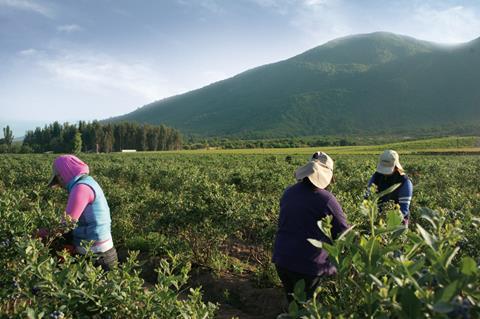CBC executive director Andrés Armstrong said consistency and quality are the best way to sustain value of exports

Chilean exports of fresh blueberries will remain virtually unchanged in 2025/26, climbing 1 per cent to 91,500 tonnes. Behind this relatively modest increase, however, lies a marked transformation in the industry as it continues to overhaul its planted varieties as it attempts to bring its offer more in line with market demand.
According to Andrés Armstrong, executive director of the Chilean Blueberry Committee, the pace of varietal replacement has increased significantly. Traditional varieties are declining, while replacement varieties are showing double-digit growth. New varieties are now thought to account for more than 4,000ha of Chile’s total planted area of 15,700ha.
“The result is a more robust mix, with replacement varieties contributing a quarter of fresh exports, compared to 21 per cent the previous year,” Armstrong says, adding that “this mix improves travel conditions and post-harvest shelf-life, and is more in line with what the new blueberry consumer is looking”.
Speaking at the recent Fruittrade 2025 conference in Santiago, Chile, Armstrong issued a direct message for the country’s exporters: consistent quality and varietal replacement are the key to defending Chile’s position in international markets.
After several years of declining shipments in the face of mounting competitive pressure from Peru, Mexico, Morocco, and China, the Chilean industry reached a turning point in 2024. Armstrong said this was due to improved international prices, and the structural shift in Chilean supply toward more competitive genetic materials and a distribution system better aligned with retail demands.
Of the 4,000ha of new varieties, approximately 1,000ha are still in the formative stage, which indicates that they will make up a growing proportion of total exports in the next two or three seasons. According to Armstrong, this will allow Chile to continue to make quality improvements while maintaining stable export volumes so as not to strain the sector’s cost structure.
Monitoring carried out by the committee last season also shows that the condition of arrivals improved significantly last season. By week 42, 100 per cent of verified shipments were classified of “good” or “very good”.
A price/volume analysis reviewed by Armstrong suggests that, following the supply shock caused by the El Niño phenomenon, volumes bounced back last season, supported by improved average quality. “In the US, even with volume recovery, prices did not fall to 2021 levels, reinforcing the theory that value is sustained when the market receives fruit that consistently delivers,” he said.
Armstrong noted that the task for the present season is to “continue advancing the supply chain, leveraging new genetics and supported by promotion, to seek out new consumers that will allow for expanding blueberry consumption”.
He pointed out that Chile still has a long way to go to systematically match the standards of competitors like Peru and Mexico in each supply window. With Peru ramping up volumes in the US and Chile facing growing competition from Morocco and South Africa in Europe, Armstrong said exporters should focus on fruit specifications and arrival fulfilment rather than volume.
In Asia, meanwhile, he said Chile has been losing ground in China to Peru and also domestic supply. On the plus side, South Korea has emerged as a promising market for Chilean exporters.
Armstrong noted that the frozen channel has served as an indispensable buffer for producers, providing an alternative outlet for fruit that failed to make the grade in the fresh market. Chile exported almost 68,000 tonnes of frozen blueberries in 2024/25.
He concluded by saying that last season’s positive results lay the foundation for restoring confidence in Chile as a source of origin and driving further growth in the future. “Incorporating more efficient logistics services, agronomic management, and harvest management focused on quality will allow for progress in quality consistency, which makes it possible to highlight one of the most valued characteristics of Chilean fruit: its flavour,” he said.



